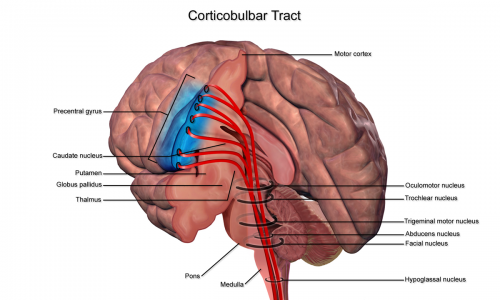Corticobulbar Tract: Difference between revisions
Kate Sampson (talk | contribs) No edit summary |
Kate Sampson (talk | contribs) No edit summary |
||
| Line 16: | Line 16: | ||
=== Course / Path === | === Course / Path === | ||
- The corticobulbar tracts leave the cerebral crus adjacent to the corticospinal tract | - The corticobulbar tracts leave the internal capsule and enter the basilar part of the pons as numerous bundles <ref name="Young" /> The fibres leave the cerebral crus adjacent to the corticospinal tract. The fibres can take several paths and have several different terminations: | ||
i) Termine directly on alpha motor neurones or interneurones innervating alpha motorneurons in the brainstem. These control somatic motor acitivity in the head e.g. muscles that control mastication, expression and eye movement.<ref name="Brown " /> | |||
ii) Axons that innervate motor nerve cranial nuclei can decussate (cross) before they terminate, resulting in them innervating contralateral muscles. As some decussate and some descend ipsilaterally, it results in bilateral descending control. <ref name="Brown " /> | |||
iii) Directly innervate cranial nervces or through interneurones I.E. via the corticospinal tract. <ref name="Brown ">Brown, AC. Physiology & Neuroscience Web Sites. Neuroscience: Motor Systems. http://www.acbrown.com/neuro/Lectures/Motr/NrMotrPrmr.htm (accessed 6/5/2016)</ref> | |||
<br> | |||
<br> | |||
The corticobulbar tract is formed from upper motoneurons located primarily in the ventral part of the precentral gyrus, the head region. The fibers accompany the corticospinal tract through the corona radiata and the internal capsule. Below this level the corticobulbar fibers are difficult to trace. Some descend in relation to the corticospinal fibers, others in the tegmentum of the midbrain, pons and medulla. <br> | The corticobulbar tract is formed from upper motoneurons located primarily in the ventral part of the precentral gyrus, the head region. The fibers accompany the corticospinal tract through the corona radiata and the internal capsule. Below this level the corticobulbar fibers are difficult to trace. Some descend in relation to the corticospinal fibers, others in the tegmentum of the midbrain, pons and medulla. <br> | ||
Revision as of 16:25, 5 June 2016
Original Editor - Your name will be added here if you created the original content for this page.
Top Contributors - Kate Sampson, Lucinda hampton, Ahmed M Diab, 127.0.0.1, WikiSysop and Kim Jackson
Description[edit | edit source]
Anatomy[edit | edit source]
Origin[edit | edit source]
- Motor cortex (precentral gyrus and anterior part of the paracentral lobule) [1]
Course / Path[edit | edit source]
- The corticobulbar tracts leave the internal capsule and enter the basilar part of the pons as numerous bundles [1] The fibres leave the cerebral crus adjacent to the corticospinal tract. The fibres can take several paths and have several different terminations:
i) Termine directly on alpha motor neurones or interneurones innervating alpha motorneurons in the brainstem. These control somatic motor acitivity in the head e.g. muscles that control mastication, expression and eye movement.[2]
ii) Axons that innervate motor nerve cranial nuclei can decussate (cross) before they terminate, resulting in them innervating contralateral muscles. As some decussate and some descend ipsilaterally, it results in bilateral descending control. [2]
iii) Directly innervate cranial nervces or through interneurones I.E. via the corticospinal tract. [2]
The corticobulbar tract is formed from upper motoneurons located primarily in the ventral part of the precentral gyrus, the head region. The fibers accompany the corticospinal tract through the corona radiata and the internal capsule. Below this level the corticobulbar fibers are difficult to trace. Some descend in relation to the corticospinal fibers, others in the tegmentum of the midbrain, pons and medulla.
Function[edit | edit source]
Pathology[edit | edit source]
- Unilateral leisons to the corticobular usually do not result in any clinical effect on the neck and head muscles as the lower motor neurons of the brain stem recieve bilateral corticobulbar innervation. [3] However there are two exceptions to these rules:
1) Facial nucleus (VII): The muscles of the lower face recieve contralateral input from the opposite motor cortex. Therefore contralateral leisons to the motor cortex/internal capsule results in weakness to the face muscles in the opposite side of the face. However they would still be able to wrinkle their forehead as this is bilaterally innervated by the corticobulbar tract. [3]
2) Hypoglossal nucleus (XII): The genioglossus muscle (muscle responsible for sticking out the tongue) receives innervation from the contralateral motor cortex. Therefore lesion involving the right motor cortex/ internal capsule would result in weakness in the left hypoglossal muscle. Therefore due to the weakness in the left side of the tongue, the strong muscle on the right side, pushes the tongue to the left. [3]
Recent Related Research (from Pubmed)[edit | edit source]
Failed to load RSS feed from http://www.ncbi.nlm.nih.gov/entrez/eutils/erss.cgi?rss_guid=10YYOHVqhl38EZ2KmODZnqbZ98ue2Llh2JVCjrXLfQ98EWWQef|charset=UTF-8|short|max=10: Error parsing XML for RSS
Resources[edit | edit source]
References[edit | edit source]
References will automatically be added here, see adding references tutorial.
- ↑ 1.0 1.1 Young, Paul. Med school Anatomy. CHAPTER 4. THE PYRAMIDAL SYSTEM. http://medschool.slu.edu/anatomy/guide_ms/chapter_4.html (accessed 6/5/2016)
- ↑ 2.0 2.1 2.2 Brown, AC. Physiology & Neuroscience Web Sites. Neuroscience: Motor Systems. http://www.acbrown.com/neuro/Lectures/Motr/NrMotrPrmr.htm (accessed 6/5/2016)
- ↑ 3.0 3.1 3.2 HyperBrain. A resource for learning Neuroanatomy. Chapter 10. Lower and Upper Motor Neurons and the Internal Capsule. http://library.med.utah.edu/kw/hyperbrain/syllabus/syllabus10.html (accessed 05/06/2016)
- ↑ Soton Brain Hub. Corticobulbar tract. https://www.youtube.com/watch?v=GfTDIGoGiY8







